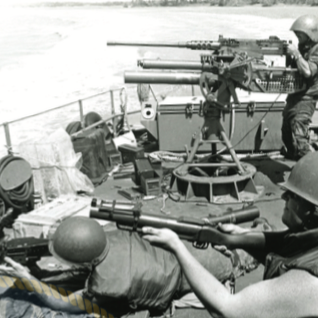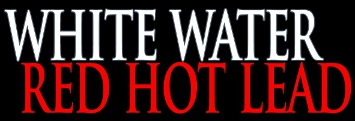FIREFIGHT
An excerpt from “White Water Red Hot Lead”:
By definition, any firefight that involved a Swift Boat was not a long, drawn-out affair simply because the enemy easily could hide while you were riding on a noisy gray boat close offshore and very visible. Therefore, the best solution for survival was a massive return of fire and, if necessary, combining it with a high-speed departure.
Standard operations in enemy territory like this was to travel close into the beach at a speed of ten knots-plus, seeing what you could observe  taking place along the shoreline or perhaps detect in the sand dunes, all the while showing the U.S. flag. Clandestine was not the operative word. The white water of the rolling wake would catch the eye, or the sound of the
taking place along the shoreline or perhaps detect in the sand dunes, all the while showing the U.S. flag. Clandestine was not the operative word. The white water of the rolling wake would catch the eye, or the sound of the
diesels would cover the audio spectrum. Some more cyni- cal observers might refer to this as drawing fire.
The first indication of trouble was when I saw several small puffs of sand along the beach. These soon led to splashes in the shallow water working their way directly toward me. Keep in mind, the Navy felt that Swift Boat officers should wear traditional khaki uniforms, with the enlisted men in dungarees. As a result, my uniform said, “I’m the man, hit me.”
Obviously this was an enemy machine gun, most likely fixed on a tripod with someone at the trigger who had enough experience to walk his rounds toward the target for better accuracy. Before the rounds even hit the water, I knew we were in trouble. Obviously they had let Lou’s boat pass by first and opened up on PCF-76 as the second
an intelligence report from “Barbados,” our coastal surveillance center (CSC). On occasion, when we conducted multiple boat operations, a more senior officer would be assigned to Swift Boats. Frankly, a senior Swift Boat skipper usually did a better job leading this type of operation. Based on experience, he knew the capabilities of the crews, boats, and weapons and the local geography. boat. This was a classic ambush technique used to minimize return fire.
I yelled for the crew to open fire and jammed the throttles forward. The big Detroit Diesels roared to life in response, but not before multiple rounds hit our boat just forward of my position. The first bullets shattered the glass in the portside cabin windows, continuing out the starboard side. The next rounds screamed by me with a metal-to-metal squeal; they drilled holes into the aluminum cabin side.
Boats was stationed at the aft .50 caliber. Both his legs were solidly spread on the deck, hands locked on the han- dles and trigger, as he sighted down the barrel and pumped out four rounds at a time with that ba-ba-ba-bab…ba-ba- ba-bab sound that only a .50 caliber can make. This firing discipline kept the recoil of the big gun from climbing up in the air and off the target. His controlled fire approach soon lost out to the locked trigger method, with the result of rapidly emptying the ammo bin. I was a firm believer in the theory that the more lead you threw at the enemy, the less likely they were to keep their heads up and continue to shoot at you.
PCF-76 started to accelerate, and we moved north of the target. Lou had seen and heard the incoming rounds, so he circled hard back at full speed and immediately turned his guns to starboard and opened fire with his twin .50 caliber forward mount. As he approached the suspected target location, he fired an 81-mm round in the trigger fire mode from his after mount toward the dune line. The round went off prematurely because it was fired too low, hit a nearby wave, and exploded, but fortunately far enough away from the boat to avoid any red hot shrapnel hitting his own crew.
After a high-speed turn, we completed a similar firing run in Lou’s wake with all guns blasting. Clearing the firing area, I did a quick survey and confirmed that we had taken some hits, but no one was injured.
—White Water, Red Hot Lead: On Board U.S. Navy Swift Boats in Vietnam
